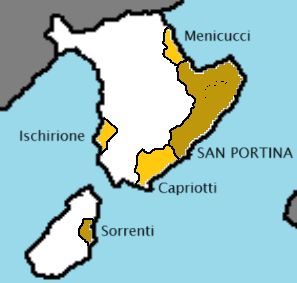San Portina
Republic of San Portina | |
|---|---|
|
Flag | |
 | |
| Capital and largest city | San Portina |
| Official languages | Qoati |
| Recognised national languages | English, Qoati |
| Government | Constitutional parliamentary monarchy |
| Salomè II | |
| Battista Nunziato | |
| Population | |
• 2020 estimate | 3,622,000 |
| Date format | mm-dd-yyyy |
The Republic of San Portina is a small nation in southern Adula bordered by Alecburgh to the north. It has a population of 3.6 million. San Portina's small geographic area is defined by a peninsula with a central mountain range, with the Croix Sea to the west, the Cantalle Ocean to the west, and the Mùnenn Strait connecting the two bodies of water. San Portina also administers 14 islands, most of which are rocky outcroppings, but the largest of which, Tùreuen Island, is inhabited. San Portina's official language is Qoati, a remnant of its establishment as a Quetanan trading outpost. The country is widely recognised as one of the most expensive and wealthiest places in the world. Through ongoing land reclamation, started in 1861 and accelerating in the 1960s, San Portina's small land mass has expanded by 8 per cent.
San Portina is a constitutional monarchy, with King Salomè II having reigned since 1999. The prime minister, who is the head of government, is currently Battista Nunziato. a member of the Coalition of Crown Albatross, the CTO, and several other international organizations. Its economy is highly diversified and the country ranks highly in human development.